
Escape Velocity is a single-player role-playing space trading and combat video game series first introduced in 1996 by Ambrosia Software for the Apple Macintosh. Two other similar games based on the original, EV Override and EV Nova, followed in 1998 and 2002 respectively, the latter of which is also available on Microsoft Windows. In addition there is a trading card game available based on the storyline of the EV Nova universe.

Descent: FreeSpace – The Great War, known as Conflict: FreeSpace – The Great War in Europe, is a 1998 space combat simulation IBM PC compatible computer game developed by Volition, when it was split off from Parallax Software, and published by Interplay Productions. In 2001, it was ported to the Amiga platform as FreeSpace: The Great War by Hyperion Entertainment. The game places players in the role of a human pilot, who operates in several classes of starfighter and combats against opposing forces, either human or alien, in various space-faring environments, such as in orbit above a planet or within an asteroid belt. The story of the game's single player campaign focuses on a war in the 24th century between two factions, one human and the other alien, that is interrupted in its fourteenth year by the arrival of an enigmatic and militant alien race, whose genocidal advance forces the two sides into a ceasefire in order to work together to halt the threat.
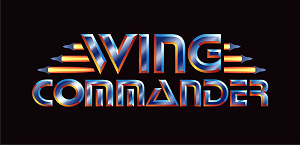
Wing Commander is a media franchise consisting of space combat simulation video games from Origin Systems, Inc., an animated television series, a feature film, a collectible card game, a series of novels, and action figures. The franchise originated in 1990 with the release of video game Wing Commander.

Ground Control is a real-time tactics video game developed by Massive Entertainment and published by Sierra Studios. It was first released onto the PC Microsoft Windows in 2000. The game focuses on a conflict between two factions vying for control of a planet and a series of alien artefacts contained on its surface, in which players take the role of an officer for each faction, working to achieve their objectives through using a variety of futuristic style of troops, engaging different tactics that make use of their units, the terrain and careful planning.

StarCraft: Brood War is the expansion pack for the military science fiction real-time strategy video game StarCraft. Released in December 1998 for Microsoft Windows and June 1999 for Mac OS, it was co-developed by Saffire and Blizzard Entertainment. The expansion pack introduces new campaigns, map tilesets, music, extra units for each race, and upgrade advancements. The campaigns continue the story from where the original StarCraft ended, with the sequel, StarCraft II: Wings of Liberty, continuing from the conclusion of Brood War. The expansion was released first in the United States on December 18, 1998.

Battlezone is a first-person shooter real-time strategy video game, developed and published by Activision. It was released for Microsoft Windows in 1998. Aside from the name and presence of tanks, this game bears little resemblance to the original arcade game of the same name. Activision remade it into a hybrid of a tank simulation game, a first-person shooter and a real-time strategy game. In Battlezone the player is controlling everything on the battlefield from the first person view.

Star Wars: Dark Forces is a first-person shooter video game developed and published by LucasArts. It was released in 1995 for MS-DOS and Macintosh, and in 1996 for the PlayStation. The story is set in the fictional Star Wars expanded universe and begins shortly before the original Star Wars film, before flashing forward to a year after the film's events. The game's protagonist and playable character is Kyle Katarn, a mercenary working on behalf of the Rebel Alliance who discovers the Galactic Empire's secret Dark Trooper Project, which involves the development of a series of powerful new battle droids and power-armored stormtroopers.

Terminal Velocity is a simulation video game originally developed by Terminal Reality and published by 3D Realms for DOS and Windows 95 and MacSoft for Mac OS. It is an arcade-style flight combat game, with simpler game controls and physics than flight simulators. It is known for its fast, high-energy action sequences, compared to flight simulators of the time.
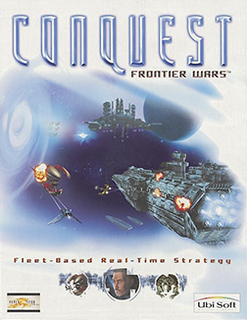
Conquest: Frontier Wars is a real-time strategy game released in 2001 by Ubi Soft and developed by Fever Pitch Studios. A good amount of the development was done at Digital Anvil in Austin, Texas, a startup developer originally owned by Chris Roberts, Erin Roberts, Eric Peterson, John Miles, Tony Zurovec, Marten Davies and Robert Rodriguez. Once Microsoft purchased Digital Anvil, Eric Peterson and Tom Mauer left to form Fever Pitch Studios Inc, and lead a team to complete the game as originally intended by the team. On December 9, 2013, the source code was bundled with every copy of the game purchased on GOG.com.
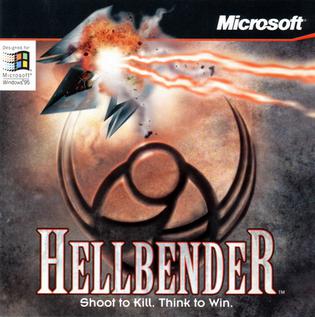
Hellbender is a simulation video game developed by Terminal Reality and published by Microsoft Studios for Windows 95. It is the sequel to Fury3. A demo version of the game was included on later CD-ROM versions of Windows 95. The voice of the ship's computer is portrayed by Gillian Anderson.

Wing Commander III: Heart of the Tiger is the third main game in Chris Roberts' Wing Commander science fiction space combat simulation video game series, developed and released by Origin Systems in December 1994. It was a departure from previous games in the series in that it uses extensive live action full-motion video to add an interactive movie-style presentation to the space combat gameplay, emphasized by its advertising slogan, "Don't watch the game, play the movie!". The game's more than two hours of video featured a number of prominent movie stars including Mark Hamill as Colonel Christopher "Maverick" Blair, Malcolm McDowell as Admiral Tolwyn, John Rhys-Davies as James "Paladin" Taggart and Thrakhath nar Kiranka, and Tom Wilson as Todd "Maniac" Marshall.

Wing Commander: Armada is a computer game set in the universe of Chris Roberts' Wing Commander franchise. Created by Origin Systems and distributed by Electronic Arts in 1994, Armada was the first official game of the Wing Commander series to feature multiplayer mode. This game was released shortly before Wing Commander III: Heart of the Tiger and features a new graphics engine, capable of rendering fully 3D ship models, which is more powerful than the sprite-based engine used in Wing Commander II: Vengeance of the Kilrathi.
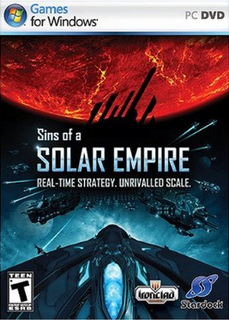
Sins of a Solar Empire is a 2008 science fiction real-time strategy video game developed by Ironclad Games and published by Stardock Entertainment for Microsoft Windows operating systems. It is a real-time strategy (RTS) game that incorporates some elements from 4X games; its makers describe it as "RT4X". Players are given control of a spacefaring empire in the distant future, and are tasked with conquering star systems using military, economic and diplomatic means.

Wing Commander: Privateer is an adventure space trading and combat simulator computer game released by Origin Systems in September 1993. Privateer and its storyline is part of the Wing Commander series. The player takes the role of Grayson Burrows, a "privateer" who travels through the Gemini Sector, one of many sectors in the Wing Commander universe. Unlike Wing Commander, the player is no longer a navy pilot, but a freelancer who can choose to be a pirate, a merchant, a mercenary or any of the above in some combination. The player may follow the built-in plot but is free to adventure on his own, even after the plot has been completed.
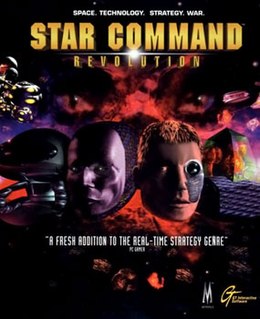
Star Command: Revolution is a real-time strategy game developed by Metropolis Digital, Inc. and published by GT Interactive. It was originally released in 1997 for MS-DOS, and was re-released in 1998 for Microsoft Windows under the title Star Command Deluxe. This re-release was overshadowed by its contemporary, Starcraft. A sequel, Star Command X: Armada, is hinted at upon successful completion of the campaign mode, but it was never produced. So they to change the title to just Armada and it was released on November 26, 1999.
X is a science fiction space trading and combat simulator series created by German developer Egosoft. The series is set in the X-Universe where several races populate a number of worlds connected by jumpgates. The games feature free roaming gameplay with trading, combat, empire building, and missions; leading to the series' phrase: "Trade, Fight, Build, Think". The series, which was launched in 1999 on the Windows platform, consists of five base games: X: Beyond the Frontier, X2: The Threat, X3: Reunion, X Rebirth, and X4: Foundations. X Rebirth introduced a new rendering engine as well as a new plot, one which X4: Foundations now extends the storyline beyond ten years after the events in X Rebirth.
Blizzard Entertainment's real-time strategy game series StarCraft revolves around interstellar affairs in a distant sector of the galaxy, with three species and multiple factions all vying for supremacy in the sector. The playable species of StarCraft include the Terrans, humans exiled from Earth who excel at adapting to any situation; the Zerg, a race of insectoid aliens obsessed with assimilating other races in pursuit of genetic perfection; and the Protoss, a technologically advanced humanoid species with psionic abilities that attempts to preserve their civilization and strict philosophical way of living from the Zerg. Each of these races is the focus of a series of missions in the single-player campaign of each StarCraft real-time strategy game. In addition to these three, various non-playable races have also been part of the lore of the StarCraft series; the most notable of these is the Xel'Naga, an ancient god-like race which features prominently in the fictional histories of the Protoss and Zerg.
Escape Velocity Override is a space trading simulator game written by Peter Cartwright, with the support of his school-friends, and developed by Ambrosia Software for the Apple Macintosh. It is the sequel to Escape Velocity with an extended version of the original game engine, but Override has an entirely new story line set in a different, larger universe.

StarCraft II: Legacy of the Void is a standalone expansion pack to the military science fiction real-time strategy game StarCraft II: Wings of Liberty, and the third and final part of the StarCraft II trilogy developed by Blizzard Entertainment. The game was released on November 10, 2015.
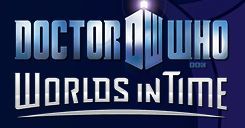
Doctor Who: Worlds in Time was a massively multiplayer online role-playing game created for the Adobe Flash platform developed by Grey Havens. It was based on the science fiction series Doctor Who and was commercially released on 12 March 2012 and was closed on 3 March 2014.

















